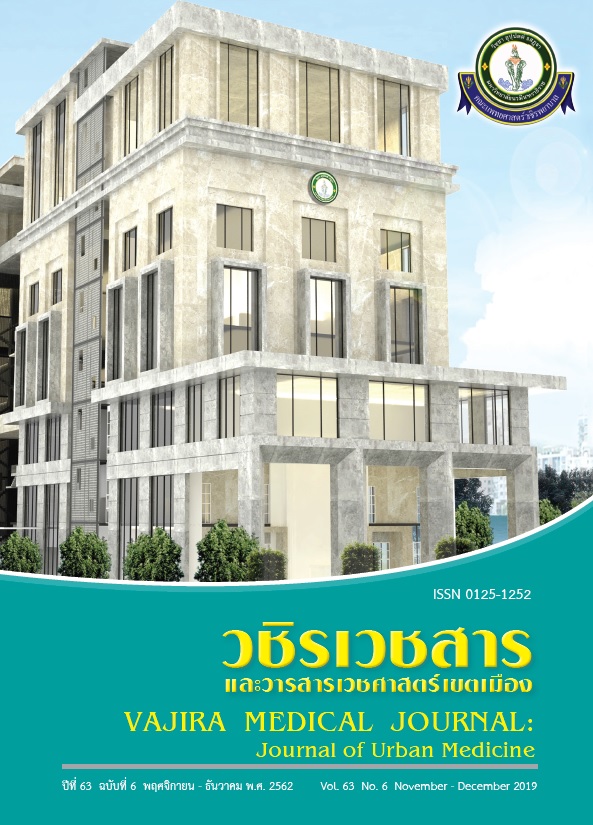Early Rehabilitation Program with Mobilization Technique after Arthroscopic Rotator Cuff Repair: A Case Report
Main Article Content
Abstract
Physiotherapy is an important element for rehabilitation in a patient after arthroscopy rotator cuff repair. A rehabilitation program is used to fulfil the goal of the operation. A stiff shoulder is a very common symptom after arthroscopy rotator cuff repair. Using a rehabilitation protocol is still controversial as to whether or not patients should move the shoulder as soon as possible. Moreover, there are various techniques to improve movement of the shoulder at each phase of rehabilitation. It is still unclear which protocol is the most effective rehabilitation after arthroscopy. I found that starting the program 1 day after arthroscopic rotator cuff repair together with a mobilization technique in one patient. Two days after the operation the patient was able to perform routine daily activities with some help, such as putting on and taking off clothes and a shoulder abduction pillow and eating. Seven days after the operation pain was completely gone, passive range of motion of the shoulder increased in flexion and abduction to 150 ° and 120° respectively, and reached full range of motion on day 14 after the operation. Two months after the operation, the patient could do full active range of motion except hand behind back (internal rotation of shoulder) until the hands reach the 4th–5th lumbar of the spine with stiffness at the end of the range of motion. The patient could do these activities by herself except that some activities could cause stiffness at the end of the range of motion such as hooking a bra. Three months after the operation, the patient had full range of motion in every direction, could do normal activities daily living and started to exercise with the theraband. These programs are recommended to physical therapists during rehabilitation for arthroscopic rotator cuff repair to support rapid reintegration into activities of daily living.
Downloads
Article Details
References
Colvin AC, Egorova N, Harrison AK. Nation trends in rotator cuff repair. J Bone Joint Surg AM 2012;94: 227-33.
McCaarron JA, Derwin KA, Bey MJ. Failure with continuity in rotator cuff repair “healing”. AM J Sport Med 2013; 41: 134-41.
Ghodadra NS, Provencher MT. Open, mini-open, and all-arthroscopic rotator cuff repair surgery: indications and implications for rehabilitation. J Orthop Sports Phys Ther 2009; 39: 81-9.
Koo SS, Burkhart SS. Rehabilitation following arthroscopic rotator cuff repair. Clin Sports Med 2010; 29(2): 203-11.
Brislin KJ, Field LD, Savoie FH. 3rd Complications after arthroscopic rotator cuff repair. Arthroscopy 2007; 23(2): 124-8.
Severud EL, Ruotolo C, Abbott DD. Allarthroscopic versus mini-open rotator cuff repair: A long-term retrospective outcome comparison.Arthroscopy 2003; 19(3): 234-8.
Tauro JC. Stiffness and rotator cuff tears: incidence, arthroscopic findings, and treatment results. Arthroscopy 2006; 22(6): 581-6.
Warner JJ, Greis PE. The treatment of stiffness of the shoulder after repair of the rotator cuff. Instr Course Lect 1998; 47: 67-75.
Millett PJ,Wilcox RB, O’Holleran JD,Warner JJ. Rehabilitation of the rotator cuff: an evaluationbased approach. J AM Acad Orthop Surg 2006;14: 599-609.
Galatz LM, Ball CM, Teefey SA. The outcome and repair integrity of completely arthroscopically repaired large and massive rotator cuff tears. J Bone Joint Surg AM 2004; 86: 219-24.
Gerber C, Schneeberger AG, Perren SM. Experimental rotator cuff repair. A preliminary study. J Bone Joint Surg AM 1999; 81(9): 1281-90.
Thomopoulos S, Williams GR, Soslowsky LJ. Tendon to bone healing:differences in biomechanical, structural and compositional properties due to range of activity levels.J Biomech Eng 2003; 125(1): 106-13.
Lastayo PC,Wright T. Continuous passive motion after repair of the rotator cuff. A prospective outcome study. J Bone Joint Surg AM 1998;80(7): 1002-11.
Rabb MG, Rzeszutko D, O’Connor W. Early results of continuous passive motion after rotator cuff repair: a prospective, randomized, blinded, controlled study. Am J Orthop 1996;25(3): 214-20.
Speer KP, Warren RF, Horowitz L. The efficacy of cryotherapy in the postoperative shoulder. J Shoulder Elbow Surg 1996; 5(1): 62-8.
Muraki T, Aoki M, Uchiyama E. Strain on the repaired supraspinatus tendon during manual traction and translational glide mobilization on the glenohumeral joint: a cadaveric biomechanics study. Man Ther 2007; 12(3): 231-9.
Johnson AJ, Godges JJ. The effect of anterior versus posterior glide joint mobilization on external rotation range of motion in patients with shoulder adhesive capsulitis. J Orthop Sports Phys Ther 2007; 37(3): 88-99.
Meijdent OA, Westgard P, Chandler Z, Gaskill TR, Kokmeyer D, Millett. Rehabilitation after arthroscopic rotator cuff repair current concepts review and evidence-based guidelines. Int J Sports Phys Ther 2012; 7(2): 197-218.
Parson BO, Gruson KI, Chen DD. Does slower rehabilitation after arthroscopic rotator cuff repair lead to long-term stiffness? J Shoulder Elbow Surg 2010; 19: 1034-9.
Cuff DJ, Pupello DR. Prospective randomized study of arthroscopic rotator cuff repair using an early versus delayed postoperative physical therapy protocol. J Shoulder Elbow Surg 2012;21: 1450-5.
Conroy DE, Hayes KM. The effect of joint mobilization as a component of comprehensive treatment for primary shoulder impingement syndrome. J Orthop Sports Phys Ther 1998;28(1): 3-14.
Senbursa G, Baltaci G, Alay A. Comparison of conservative treatment with and without manual physical therapy for patients with shoulder impingement syndrome. Knee Surgery Sports Traumato Arthrosc 2007; 15; 915-21.
Berbman GJD, Winter JC, Heijden G. The effect of manipulation of the structures of the shoulder girdle as additional treatment for symptom relief and for prevention of chronicity or recurrence of shoulder symptoms. J Manipulative Physiol Ther 2002; 25: 543-9.
Lorbach O, Baums MH, Kostuj T. Advance in biology and mechanics of rotator cuff repair. Knee Surg Sports Traumatol Arthrosc 2015; 23:530-41.
Shimo S, Sakamoto Y, Tokiyoshi A, Yamamoto Y. Early rehabilitation affects functional outcomes and activities of daily living after arthroscopic rotator cuff repair: a case report. J Phys Ther Sci 2016; 28: 714-7.
Burmaster C, Eckenrode BJ, Stiebel M. Earrly incccorporation of an evidence-based aquaticassisted approach to arthroscopic rotator cuff repair rehabilitation: prospective case study. Phys Ther 2016; 96(1): 53-61.


